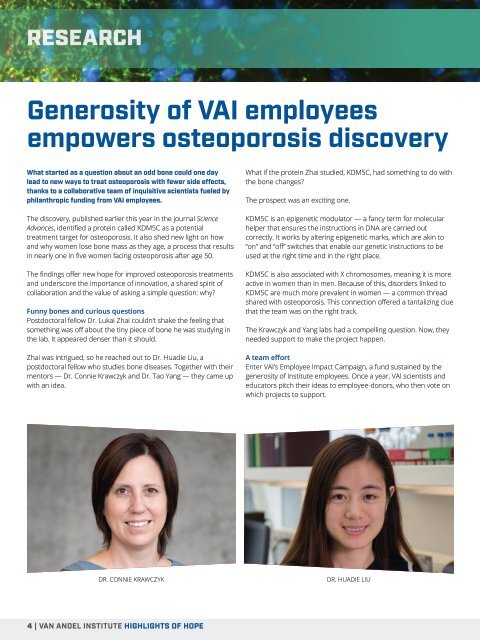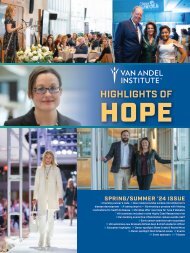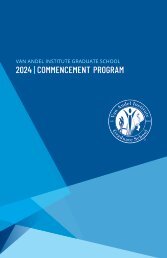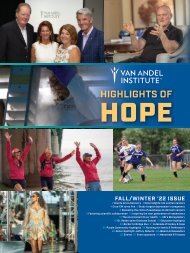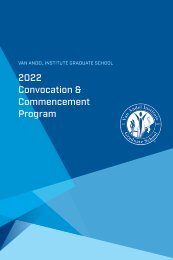2023 Fall/Winter Highlights of Hope
This is the 2023 Fall/Winter edition of Van Andel Institute's Highlights of Hope donor publication.
This is the 2023 Fall/Winter edition of Van Andel Institute's Highlights of Hope donor publication.
You also want an ePaper? Increase the reach of your titles
YUMPU automatically turns print PDFs into web optimized ePapers that Google loves.
RESEARCH<br />
Generosity <strong>of</strong> VAI employees<br />
empowers osteoporosis discovery<br />
What started as a question about an odd bone could one day<br />
lead to new ways to treat osteoporosis with fewer side effects,<br />
thanks to a collaborative team <strong>of</strong> inquisitive scientists fueled by<br />
philanthropic funding from VAI employees.<br />
The discovery, published earlier this year in the journal Science<br />
Advances, identified a protein called KDM5C as a potential<br />
treatment target for osteoporosis. It also shed new light on how<br />
and why women lose bone mass as they age, a process that results<br />
in nearly one in five women facing osteoporosis after age 50.<br />
The findings <strong>of</strong>fer new hope for improved osteoporosis treatments<br />
and underscore the importance <strong>of</strong> innovation, a shared spirit <strong>of</strong><br />
collaboration and the value <strong>of</strong> asking a simple question: why?<br />
Funny bones and curious questions<br />
Postdoctoral fellow Dr. Lukai Zhai couldn’t shake the feeling that<br />
something was <strong>of</strong>f about the tiny piece <strong>of</strong> bone he was studying in<br />
the lab. It appeared denser than it should.<br />
Zhai was intrigued, so he reached out to Dr. Huadie Liu, a<br />
postdoctoral fellow who studies bone diseases. Together with their<br />
mentors — Dr. Connie Krawczyk and Dr. Tao Yang — they came up<br />
with an idea.<br />
What if the protein Zhai studied, KDM5C, had something to do with<br />
the bone changes?<br />
The prospect was an exciting one.<br />
KDM5C is an epigenetic modulator — a fancy term for molecular<br />
helper that ensures the instructions in DNA are carried out<br />
correctly. It works by altering epigenetic marks, which are akin to<br />
“on” and “<strong>of</strong>f” switches that enable our genetic instructions to be<br />
used at the right time and in the right place.<br />
KDM5C is also associated with X chromosomes, meaning it is more<br />
active in women than in men. Because <strong>of</strong> this, disorders linked to<br />
KDM5C are much more prevalent in women — a common thread<br />
shared with osteoporosis. This connection <strong>of</strong>fered a tantalizing clue<br />
that the team was on the right track.<br />
The Krawczyk and Yang labs had a compelling question. Now, they<br />
needed support to make the project happen.<br />
A team effort<br />
Enter VAI’s Employee Impact Campaign, a fund sustained by the<br />
generosity <strong>of</strong> Institute employees. Once a year, VAI scientists and<br />
educators pitch their ideas to employee-donors, who then vote on<br />
which projects to support.<br />
DR. CONNIE KRAWCZYK<br />
DR. HUADIE LIU<br />
4 | VAN ANDEL INSTITUTE HIGHLIGHTS OF HOPE


